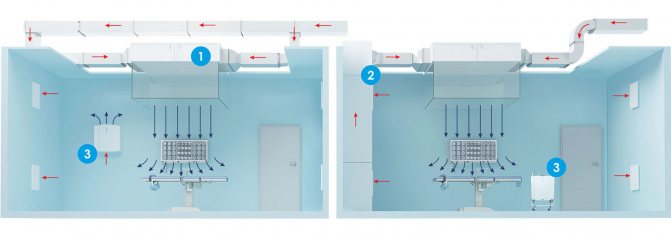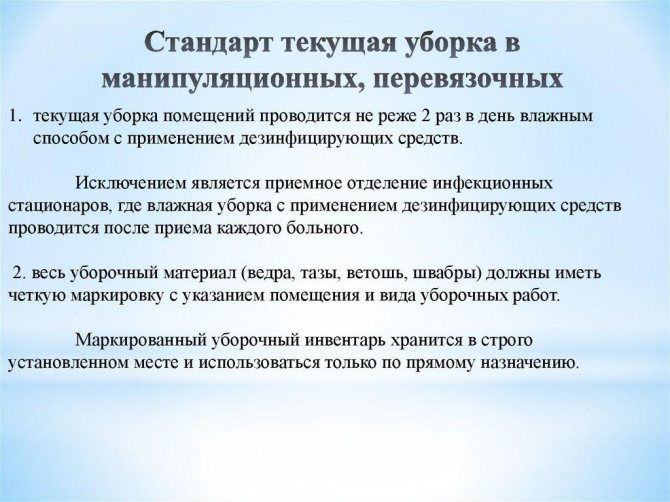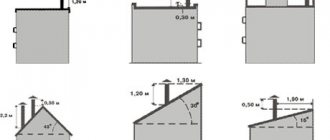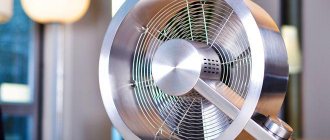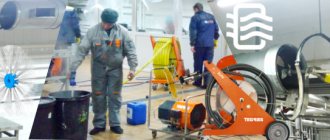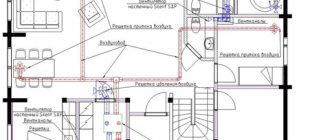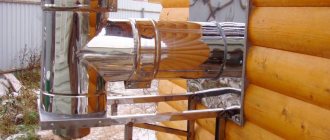The essence of the ventilation system is to maintain a healthy indoor microclimate, regulate cleanliness, humidity and air temperature. In order for the system to work properly throughout its service life, it is necessary to regularly disinfect the ventilation and air conditioning systems. To understand the need for these measures, it is important to know the consequences of pollution in the ventilation system.
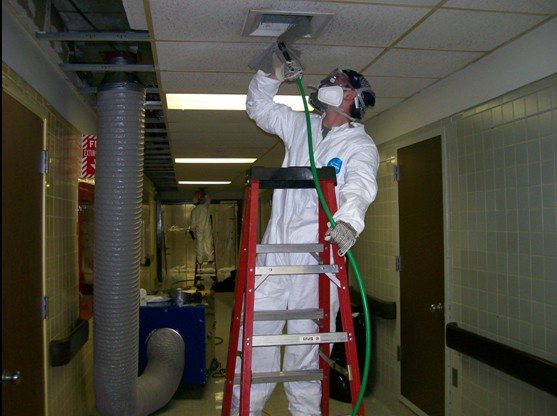
Contaminated ventilation: hazards and risks
Air ducts of ventilation systems during operation are gradually covered with a layer of dust and fat deposits. Interacting with condenser moisture, they form strong deposits on the walls inside. Cleaning and disinfection of ventilation should be performed regularly without fail, since these deposits in ventilation pipes are dangerous for both domestic and office premises.
For private premises, offices and other institutions
The main danger that comes from them is the multiplication of pathogenic bacteria, which, in turn, negatively affects people's health. Such plaques are a favorable environment for the intensive multiplication of bacteria and viruses. The air entering the room is not sufficiently cleaned, and this leads to a decrease in immunity, constant headaches, poor health, and general weakness. Air masses circulate very weakly and slowly.
Important! According to the WHO (World Health Organization), the air in rooms with polluted ventilation is 6 times dirtier than outside and 10 times more toxic than it.
In addition, a dusty and dirty ventilation duct network is a good conductor of fire. Dry dust can instantly ignite, from which suffocating and acrid smoke penetrates into an apartment or office through the air duct.
For catering establishments and medical institutions
For medical institutions and catering establishments, there is a high risk of microbial contamination of both equipment and tools to the edge of the already mentioned hazards. Dust and mud deposits, which penetrate into these premises, constantly spreading through it, nullify all efforts to achieve the required cleanliness and sanitation.
Therefore, disinfection of ventilation is a mandatory and extremely important procedure, regulated by a whole package of legislative acts, which must be carried out using special equipment and special means.
Disinfection of ventilation systems is mandatory
Disinfection of ventilation systems should be carried out:
- In manufacturing plants.
- In industrial and transport enterprises.
- In medical and educational institutions.
- Shopping and entertainment and business centers.
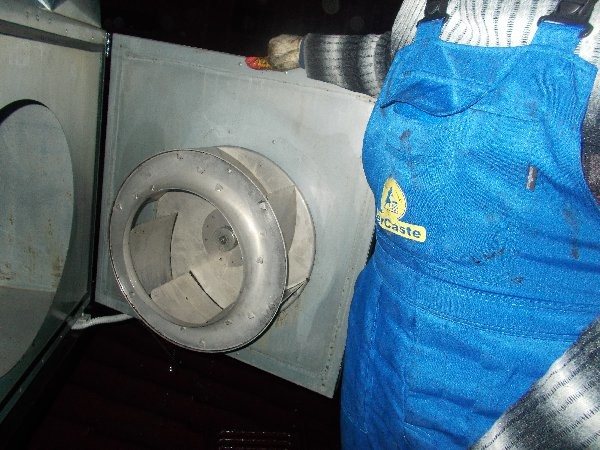

In other words, at all, without exception, facilities that are equipped with flow and exhaust ventilation systems. Disinfection of ventilation and air conditioning systems is the removal of dirt, grease and any other deposits inside the ventilation pipelines with further disinfection.
Types of dirt on the inner walls of the ventilation


Dust, grease, soot accumulate in the ventilation ducts, mold forms
Depending on the room in which the ventilation system is located, various types of dirt can form on its inner walls.
- Dust. These are dry suspensions in the form of flakes, which are located on filters, walls of an air duct or air conditioning system. Dust is considered the most flammable. Light flakes ignite quickly from the slightest spark. The flame can spread throughout the ventilation system to several rooms at once.
- Mold and fungal growth. Most often, they are formed under conditions of high humidity in the room, or if condensation regularly forms on the walls of the line due to temperature changes. It is mold and mildew, getting into the rooms through the ventilation grilles, that are the cause of the development of complex allergic reactions.
- Rust. Also formed due to high humidity or condensation inside the ventilation system. Sooner or later, rust breaks the tightness of the line, which reduces the efficiency of the entire communication.
- Fat and fatty soot. As a rule, they are formed in the ventilation lines of public catering or food production buildings. Therefore, the disinfection of ventilation must be especially careful here. Due to the high accumulation of fatty soot, the performance of the line decreases. The ventilation system cannot cope with the flow of air masses. There are smells of soot and burning in the room. They are unpleasant in themselves and poison the human body with fumes. In addition, fatty soot destroys axial fans and grease traps. In the event of a fire, it is extremely difficult to extinguish such deposits. Therefore, cleansing the system is especially important.
- Chemical and reagent deposits. Formed in the ventilation ducts of laboratories, chemistry and physics rooms. If such deposits are not removed from the inner walls of the line in time, they threaten human health.
- Dirt after a fire or flood. These situations are force majeure. The maximum amount of soot, smoke and water accumulates on the walls of the ventilation shaft. Even after major repairs, in the absence of cleaning, they remain there, through the ventilation grilles they again enter the room. They poison a person, provoke the settling of mold and mildew on the walls.
Any kind of dirt must be removed before mechanical disinfection.
Cleaning the ventilation ducts: the main signs
The following signs can indicate that disinfection of ventilation in an apartment building is needed:
- Dust and cobwebs begin to collect around the grill on the ventilation duct.
- A layer of dust accumulates on the floor. Even a day after cleaning.
- It becomes very stuffy in an apartment or other room, which has not happened before.
Cleaning and disinfection of ventilation systems in urban apartments should be performed much more often than residents think about it. It cannot be carried out unauthorizedly - this must be done by specialists who have the appropriate documents and licenses for disinfection of ventilation.
Disinfectants
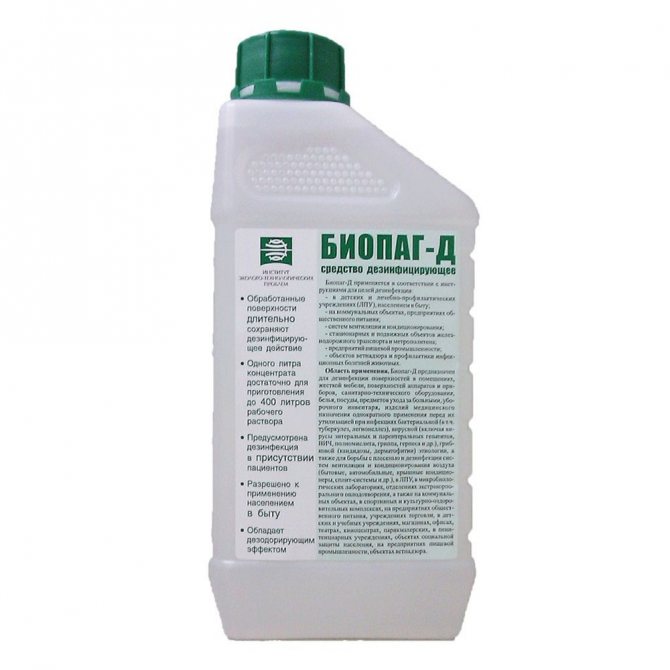

To eliminate pathogenic flora from the inner walls of the ventilation shaft, aggressive alkaline compounds are used. The entire procedure is performed only in protective clothing, a mask and glasses, in accordance with the requirements of sanitary standards. After disinfection, the room must be ventilated, the entire system is run in a test mode.
The concentration and type of disinfectant solution is selected according to the result of a previously conducted laboratory analysis with a flush. The most common chemicals for disinfection of ventilation in medical institutions and other facilities:
- Biopag-D;
- Aquaminol-Forte;
- Freesept.
Before disinfection in residential buildings, it is important to notify the neighbors about the upcoming event, otherwise vapors of chemical compounds can get into neighboring rooms and harm a person.
Equipment for disinfection of air ducts of ventilation systems
Ventilation disinfection equipment used today:
- Brushing machines.
- Filtering installations.
- Vacuum machines.
The brushing machine for cleaning ventilation in office and industrial premises is equipped with special shafts with a diameter of 25 to 40 mm
.
Pneumatic machines are capable of cleaning pipelines with a diameter of 100 to 1200 mm.Some models are equipped with additional disinfection accessories.
The flexible shaft is able to get to hard-to-reach places: valves of grids, branch pipes of branches from the main channel. They are most often used to clean air ducts in government-owned apartment buildings.
Vacuum installations. The quality of cleaning with this equipment depends on the selected power of the machine. Large objects require powerful models.
Ventilation cleaning methods
Nowadays, among the services provided by specialized companies, there is also a ventilation cleaning service. But if you don’t want to pay, and you think you’ll do a great job yourself, then you can take matters into your own hands.
So, there are two options for the development of events:
- involvement of third-party specialists;
- performing work on your own.
We clean the channel ourselves
If you live in a high-rise building, then your ventilation hole goes into a common ventilation shaft, which rises to the roof through all floors.
Unfortunately, it is only on rare occasions that this mine has a separate channel for each apartment. Most often this is one common channel passing through all apartments located one above the other. It is for this reason that when cravings are impaired, you can smell the smells spreading from the kitchens of your neighbors.
In order to clean the channel yourself, you need to take the following steps:
- Free the space under the ventilation duct from the stove and kitchen furniture. Place old newspapers on the floor as dirt may spill over the channel.
- Place a stool or stepladder against the wall.
- Cover the wall under the canal with newspapers - wallpaper, paint or tiles may be contaminated by crumbling deposits from the walls of the canal.
- Remove the ventilation grill, wash it with soap or powder. If it is old and yellow, it should be replaced with a new one of suitable size.
- Wear thick gloves on your hands and gently scoop all debris and dirt out of the canal. Proceed with caution, as there may be sharp stones or pieces of mortar, nails, glass and other unpleasant debris, up to dead mice and insects.
- If you are not sorry to clog the vacuum cleaner, then the remains of small debris can be removed with its help.
- Reinstall the ventilation grill and check the draft in a way that is already known to you.
If there is still no thrust, then the channel is clogged higher. This is a problem, since you cannot reach the blockage. There is only one way out - to attract a management company, since for sure you are not alone on this riser suffering without ventilation.
We attract specialists
If you live in a private house and you have an extensive ventilation system, then you will not be able to clean it yourself. More precisely, it will succeed, but only with the use of special mechanized equipment, which you probably do not have.
Besides, you hardly know how to use it.
In order to clean your ventilation, specialists can use several methods.
These are methods such as:
- mechanical - a vacuum cleaner and a brush machine are used (cleaning is done quickly, but does not effectively remove fat deposits);
- chemical - by spraying special chemicals inside the air duct (it is necessary to completely seal it, because chemistry is toxic);
- combined - combines the previous two methods that are used alternately (expensive but effective method)
- blasting - consists in spraying particles of soda or dry ice inside the air duct using compressed air (also requires complete sealing of the system and quite a significant time, but is very effective).
How is ventilation disinfected?
At the next stage, a decision is made on what methods will be used for cleaning: the type of equipment used for cleaning and an antibacterial agent for disinfecting ventilation ducts.Air ducts are cleaned by two main methods:
- Mechanical cleaning. It implies the use of alkaline machines and industrial vacuum cleaners with increased power. This method also includes blowing out the ventilation ducts with compressed air. With its help, most of the dirt is blown out.
- Cleaning using chemicals that are part of specialized ventilation disinfectants approved for use in residential premises, as well as for industrial and public enterprises.
After the completion of the disinfection and cleaning activities, an assessment of the quality of the work performed should be carried out by taking analysis for research for the presence of potentially dangerous bacteria. If necessary, a decision is made on the subsequent cleaning work.
Documents on disinfection of ventilation with a description of cleaning measures are issued when the work was carried out by specialized organizations. It contains a full range of services performed, used special equipment and methods of disinfection. The documentation indicates the results of laboratory tests of the primary analysis and the final one.
Signs of clogged ventilation
It is easy to understand that the ventilation is clogged if you pay attention to the following signs:
- the air in the house has become stale;
- there is almost no draft when opening the windows;
- kitchen odors spread easily throughout the house and do not fade for a long time;
- there is an increased dust settling in the house;
- the windows began to fog up, although this was not previously observed;
- pockets of fungus and mold appeared, which indicates high humidity in the house, stagnating due to lack of ventilation.
If there is any doubt that this is caused by a clogged ventilation, then you can check its performance.
The check is carried out in one of the following ways:
- Bring a lighted match or lighter to the opening of the ventilation grill - if the flame is sucked into the duct or even goes out, then the ventilation is working normally, if the flame column remains straight, it is clogged.
- Bring a small piece of paper to the ventilation grill. If he sticks to it, then the thrust is excellent, if it falls, there is no thrust.
The first method can be dangerous if a lot of cobwebs have accumulated in the ventilation duct. It can catch fire, causing a fire. Therefore, it is better to use the second method.
If it is found that the draft is weak or not at all, it is necessary to start cleaning the ventilation.
Ventilation disinfection
During cleaning, the system fan blades, hatches and grilles must be disinfected.
Disinfection measures should be performed in case of detection of harmful microorganisms. With routine cleaning activities, disinfection as such is not necessary.
In the process of disinfection of ventilation, special means can be used both individually and in a complex - it depends on the specifics of the performance of these works. Disinfection is performed by spraying disinfectant with a soft tube, at the end of which a special nozzle is put on, which facilitates the penetration of the disinfectant into the most inaccessible places.
Do you need a license for disinfection of ventilation by enterprises and companies? Disinfection is a very responsible and important process, therefore, those organizations that have special permission and state licenses for this have the right to perform it.
Frequent mistakes and their consequences


Filters need to be changed periodically
When performing work, mistakes are often made. The most common ones are:
- Self cleaning and disinfection of highways. In this case, only a small part of the dirt is removed - which is visible. The bulk of soot, grease and rust is often hidden from the eyes of the common man. Special equipment is needed here.Therefore, self-cleaning is ineffective. Moreover, it can cause even more harm, as the accumulated grease and soot move from place to place. They subsequently enter the filters and ventilation grilles with air masses.
- Ignoring filter change. If filters and grease traps are not changed after disinfection and cleaning, the ventilation system runs at risk to human health. Throws particles of pathogenic flora accumulated on the filters into the room.
- Cleaning the system without further disinfection. Even if all the dirt is removed from the inner walls of the three shafts, pathogenic flora, fungus, bacteria still live in the cracks and joints of the highway. Therefore, disinfection is mandatory.
It is considered a dangerous mistake to invite non-professionals to clean and disinfect the ventilation shaft. Such specialists take money for work that they do illiterately. And this is the best case. At worst, they disable the ventilation system.
How to clean the grate
Before starting hygiene procedures, you need to carefully remove the grill:
- If a pipe is attached to the grill, it must be moved aside.
- Pry off the grate with a screwdriver or knife.
- Remove the grate from the hatch, being careful not to shake, so as not to brush dust, cobwebs and dirt into the air.
Important! Much depends on the purpose of the room where the grill is located. We are considering a home space. If this is a bathroom, then fat does not accumulate on it and you can simply rinse the grate in running water, drain it and put it back.


How often general cleaning is carried out in various institutions
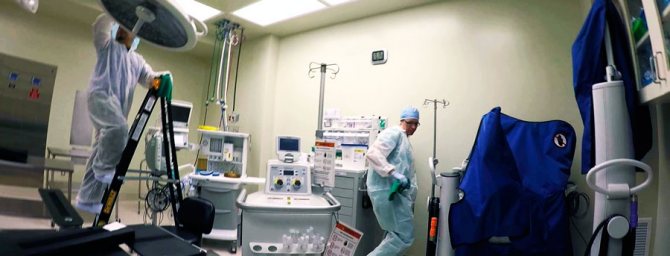

General cleaning in medical and childcare facilities
Standards have been developed specifically for medical, children's and school institutions that establish the rules for observing the sanitary and epidemiological regime. Fulfillment of this standard can be carried out by the institution's own resources or by using an outsourced service order form in our Service Cleaning company. This will help not to depend on the human factor, which often becomes the reason for fines when the inspection authorities come. A professional cleaning company performs such work with a guaranteed better quality at least through the use of specialized equipment.
General cleaning in a medical facility should be carried out at least once every 7 days.
General cleaning by the service personnel is carried out according to the schedule approved by the head of the department or organization. The head nurse, caretaker or senior educator is responsible for the quality of work in medical and children's institutions. The advantage of working with Service Cleaning consists in strict adherence to the standard and always in the presence of all the necessary equipment and detergents that are recommended for these purposes (gowns, special shoes with shoe covers, a protective apron, goggles and high rubber gloves).
The procedure for general cleaning in medical institutions, the operating unit and manipulation rooms
Please note that during general cleaning it is imperative to move all furniture and interior items, equipment, tools, etc. The whole situation is shifted to the middle of the room. For cleaning, disinfectants are used, for example, Desactin or Chlorontoin, soap and soda solution is not effective and is not used, since it does not provide the required level of cleaning.
General cleaning can be carried out without detergents, for example, by treating the room with hydrogen peroxide, after washing off the dirt with a soap and soda solution. In children's institutions, colloidal silver is often used for these purposes.
After cleaning with or without detergents, workers must leave the room and the room is kept with a disinfectant solution for the exposure time, and then washed off with clean water and a rag.Depending on the category of the room, the air can be disinfected using UV irradiators at the rate of 1 watt of power per 1 cubic meter for 60 minutes. When airing, disinfection is repeated (30 minutes).
| Cleaning object | Functional rooms | Intensive care wards | Chambers | Corridors, steps | Toilets |
| Floors | 2 times / day | 2 times / day | 1 time / day | 2 times / day | 2 times / day |
| Walls | 2 times / day | Once / week | 1 time / month | 1 time / 3 months | 1 time / day |
| Doors | 1 time / day | 1 time / day | Once / week | 1 time / month | 1 time / day |
| Door handles | 2 times / day | 2 times / day | 1 time / day | 1 time / day | 1 time / day |
| Window | 1 time / day | 1 time / day | 1 time / month | 1 time / 3 months | 1 time / 3 months |
| Window sills | 1 time / day | 1 time / day | 1 time / day | 1 time / day | 1 time / day |
| Radiators (top) | 1 time / day | 1 time / day | Once / week | 1 time / month | Once / week |
| Medicine cabinet (interior) | 1 time / day | 1 time / day | |||
| Sinks for hand washing | 2 times / day | 2 times / day | 1 time / day | _ | 1 time / day |
| Toilet bowls | — | — | — | — | as needed, but not less than 2 times / day |
After the scheduled cleaning, a log entry is made. To the question, how often general cleaning of premises is carried out in children's institutions the answer is simple - every day!
Features of general cleaning in schools
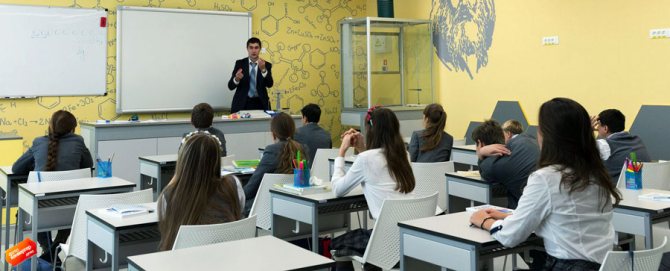

We will immediately answer the question, how often is spring cleaning done premises in the school.
General cleaning of the school premises should be carried out at least 1 time a week, as well as daily sanitary wet surface treatment.
When it comes to schools, one must always understand the difference between cleaning classrooms and cleaning the school premises. As a rule, specialized teachers supervise the general classrooms in the senior grades; in the elementary school, this responsibility is usually assigned to the parents or children. The cleaning staff only do daily cleaning.
To save parents and children from this labor obligation, it is enough to order a service from a cleaning company. If your child is attending a regular general education school, it is quite possible for parents to invite professionals 4 times a month to prepare the class for the new school week. According to the sanitary requirements, the cleaning of the premises where children spend time is carried out in compliance with the following standards:
- Cleaning is always done with the windows open;
- Parquet floors in classrooms and public areas are waxed once a month. In children's institutions, you cannot use paints only with water or with the addition of an aniline base, they are harmful to health or washed off with detergents;
- Cleaning involves thorough cleaning of the premises with disinfectants; professional companies, at the request of parents, use devices on steam generators. With their help, it is possible to achieve complete disinfection of premises without the use of chemicals;
- General cleaning optionally includes disinfection and aromatization of the air using separator vacuum cleaners, which has a particularly positive effect on allergic children during the flowering period.
Features of cleaning in kindergartens
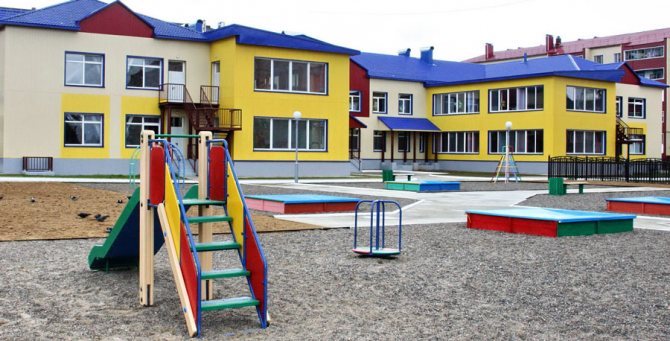

Cleaning requirements in kindergartens are more stringent than in schools. General cleaning is also carried out once a week, with high-quality work, this is usually enough to comply with sanitary and hygienic standards. In all children's institutions, it is necessary to take into account the existing problem with exo-parasites; during an epidemic, a complete disinfection is carried out in a school or kindergarten. These works are usually performed by employees of sanitary and epidemiological stations. During weekly cleaning, a supportive disinfection of rooms and interior items is carried out, especially with a textile surface.
If you are interested in high-quality general cleaning of medical and childcare facilities, it is better to contact a professional cleaning company. Our company Service Cleaning offers its services, which are of high quality, low prices and convenient terms of cooperation.With our specialists, you can count on fast and high-quality cleaning without labor costs. We guarantee excellent conditions for cooperation.
payday loans nebraska
If you still have questions on the topic "How often is the general cleaning of the premises carried out?"then fill out the form below or dial 8 (495) 640-28-18 to contact our specialists. We will help you!
Disinfection equipment
Disinfection equipment includes:
- brushing machines, tools for manual and automatic mechanical cleaning of plaque;
- vacuum filtering machines;
- pneumatic, electric sprayers;
- steam generators, vacuum cleaners.
The choice of equipment for disinfection of ventilation systems is determined by the degree and nature of the contamination.
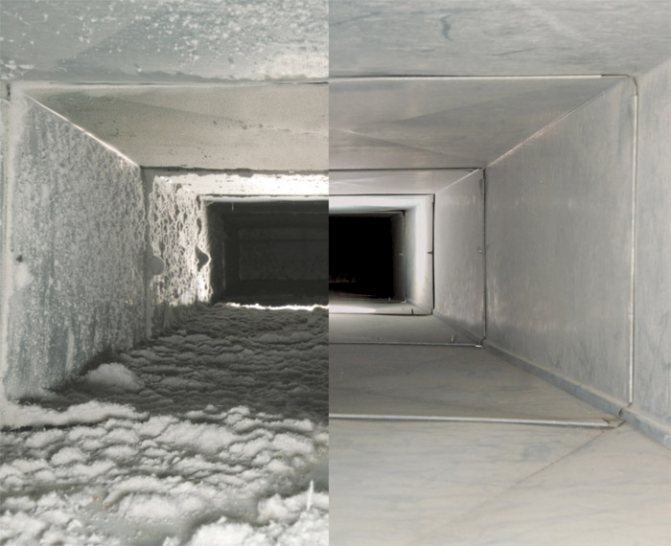

Effectively carrying out automatic dry cleaning combined with spraying disinfectants. For this, there are special nozzles on the brush machine de-sprayer with a cylinder. One such set is capable of cleaning and disinfecting a ventilation duct up to 40 m long in one pass.
Washing brush machines are used to clean ventilation ducts in bakeries and catering establishments. They are equipped with brushes of different hardness, starting with abrasive ones. Washing is carried out with the supply of alkaline solutions. To disinfect such equipment, it is enough to put an appropriate nozzle.
Note! Washing and dry cleaning of the ventilation system does not ensure its sanitary and epidemiological safety. The final stage of the work should be special processing.


